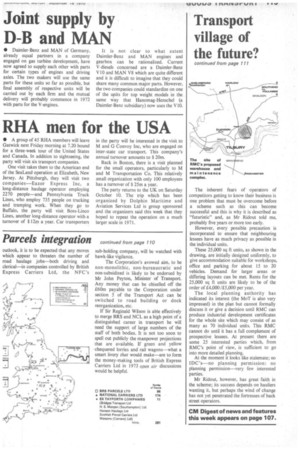Transport pillage of the future?
Page 113

Page 117

If you've noticed an error in this article please click here to report it so we can fix it.
by David Lowe • A futuristic distribution and vehicle maintenance complex has been planned by RMC Properties Ltd, a member of the Ready Mixed Concrete Ltd group of companies.
The proposed £3.2m development, on the site of one of the company's sand and gravel pits in a green belt area near Tilbury in Essex, will extend to 90 acres and will include self-contained workshop /warehouse and parking area units available on lease either singly or in multiples and service areas where tyre. fuel, repair agencies and other services can be established.
Restaurant, cafeteria and drivers' overnight accommodation facilities will be Provided and a full security vehicle park and common-user bonded warehouses are also planned.
The whole site will be fenced and screened, all the units will also be individually fenced and a network of roads and road lighting will give the appearance of a totally isolated and self-contained transport village.
The situation of the project, near the village of Linford in Essex, It miles from the busy A13 London-Southend road, and only 20 miles from central London and nine miles from Southend, is seen by the company as being in an ideal position for a project of this nature.
Mr P. C. Ridout, of RMC who conceived and designed the scheme, foresees that, as a result of the legislative pressure on operators to show that they have suitable premises in which to maintain their vehicles, many will have to look for such premises to replace the side streets, backyards and mudpatches that so many of them are currently using and have used for so many years. A convenient site of adequate size, with safe access and planning permission to build is not easy to find near any big town, city or industrial area—that is if capital is available to finance it anyway. If the operator has no capital he is faced with an almost insoluble problem.
The RMC project does offer some hope to these operators by providing suitable, ready-built facilities at economic rentals with no capital investment by the operator.
Mr Ridout hopes that some of the many small operators on the east side of London, working in conditions like those already described—and he showed me photographs to prove his point—will see the benefits to be gained by moving into the complex. They will then have premises which are acceptable to the Licensing Authority, they will have moved away from residential areas where their presence is disruptive and unsightly, and they will have all services to hand. In addition, they will have moved into a developing area for freight movement.
Tilbury, only 41 miles away, is to have its container terminal considerably extended and the busy Orsett Containerbase is in close proximity. Further expansion of trade in the lower reaches of the river beyond Tilbury is assured and the possibility of the Foulness site being selected for London's third airport adds considerably to the future trade value of the area.
The inherent fears of operators of competitors getting to know their business is one problem that must be overcome before a scheme such as this can become successful and this is why it is described as "futuristic" and, as Mr Ridout told me, probably five years or more too early.
However, every possible precaution is incorporated to ensure that neighbouring lessees have as much privacy as possible in the individual units.
These 25,000 sq ft units, as shown in the drawing, are initially designed uniformly, to give accommodation suitable for workshops. office and parking for about 15 to 20 vehicles. Demand for larger areas or differing layouts can be met. Rents for the 25,000 sq ft units are likely to be of the order of £4,000 /£5,000 per year.
The local planning authority has indicated its interest (the MoT is also very impressed) in the plan but cannot formally discuss it or give a decision until RMC can produce industrial development certificates for the whole site which may consist of as many as 70 individual units. This RMC cannot do until it has a full complement of prospective lessees. At present there are some 25 interested parties which, from RMC's point of view, is sufficient to go into more detailed planning.
At the moment it looks like stalemate; no IDC's--no planning permission: no planning permission—very few interested parties.
Mr Ridout, however, has great faith in the scheme; its success depends on hauliers wanting it. but perhaps the wind of change has not yet penetrated the fortresses of back street operators.
CM Digest of news and features this week appears on page 107.






























































































































































































































































































































































































